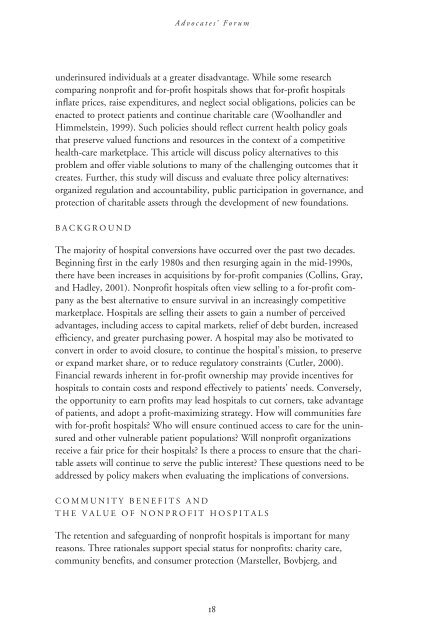2004 - School of Social Service Administration - University of Chicago
2004 - School of Social Service Administration - University of Chicago
2004 - School of Social Service Administration - University of Chicago
Create successful ePaper yourself
Turn your PDF publications into a flip-book with our unique Google optimized e-Paper software.
Advocates’ Forum<br />
underinsured individuals at a greater disadvantage. While some research<br />
comparing nonpr<strong>of</strong>it and for-pr<strong>of</strong>it hospitals shows that for-pr<strong>of</strong>it hospitals<br />
inflate prices, raise expenditures, and neglect social obligations, policies can be<br />
enacted to protect patients and continue charitable care (Woolhandler and<br />
Himmelstein, 1999). Such policies should reflect current health policy goals<br />
that preserve valued functions and resources in the context <strong>of</strong> a competitive<br />
health-care marketplace. This article will discuss policy alternatives to this<br />
problem and <strong>of</strong>fer viable solutions to many <strong>of</strong> the challenging outcomes that it<br />
creates. Further, this study will discuss and evaluate three policy alternatives:<br />
organized regulation and accountability, public participation in governance, and<br />
protection <strong>of</strong> charitable assets through the development <strong>of</strong> new foundations.<br />
BACKGROUND<br />
The majority <strong>of</strong> hospital conversions have occurred over the past two decades.<br />
Beginning first in the early 1980s and then resurging again in the mid-1990s,<br />
there have been increases in acquisitions by for-pr<strong>of</strong>it companies (Collins, Gray,<br />
and Hadley, 2001). Nonpr<strong>of</strong>it hospitals <strong>of</strong>ten view selling to a for-pr<strong>of</strong>it company<br />
as the best alternative to ensure survival in an increasingly competitive<br />
marketplace. Hospitals are selling their assets to gain a number <strong>of</strong> perceived<br />
advantages, including access to capital markets, relief <strong>of</strong> debt burden, increased<br />
efficiency, and greater purchasing power. A hospital may also be motivated to<br />
convert in order to avoid closure, to continue the hospital’s mission, to preserve<br />
or expand market share, or to reduce regulatory constraints (Cutler, 2000).<br />
Financial rewards inherent in for-pr<strong>of</strong>it ownership may provide incentives for<br />
hospitals to contain costs and respond effectively to patients’ needs. Conversely,<br />
the opportunity to earn pr<strong>of</strong>its may lead hospitals to cut corners, take advantage<br />
<strong>of</strong> patients, and adopt a pr<strong>of</strong>it-maximizing strategy. How will communities fare<br />
with for-pr<strong>of</strong>it hospitals Who will ensure continued access to care for the uninsured<br />
and other vulnerable patient populations Will nonpr<strong>of</strong>it organizations<br />
receive a fair price for their hospitals Is there a process to ensure that the charitable<br />
assets will continue to serve the public interest These questions need to be<br />
addressed by policy makers when evaluating the implications <strong>of</strong> conversions.<br />
COMMUNITY BENEFITS AND<br />
THE VALUE OF NONPROFIT HOSPITALS<br />
The retention and safeguarding <strong>of</strong> nonpr<strong>of</strong>it hospitals is important for many<br />
reasons. Three rationales support special status for nonpr<strong>of</strong>its: charity care,<br />
community benefits, and consumer protection (Marsteller, Bovbjerg, and<br />
18
















